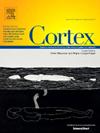中重度脑外伤成人在多模态语言处理过程中的在线语音手势整合能力降低:来自眼动追踪的证据。
IF 3.2
2区 心理学
Q1 BEHAVIORAL SCIENCES
引用次数: 0
摘要
背景介绍语言是多模态的,处于丰富的视觉语境中。语言也是渐进的,每时每刻都在实时展开,但很少有研究探讨在多模态语言处理过程中,口语是如何与手势和视觉语境相互作用的。手势是一种丰富的交流线索,它与语音紧密相关,通常描绘的是视觉世界中的具体参照物。我们在一个经过调整的视觉世界范例中使用眼动跟踪技术,研究了患有和未患有中度严重创伤性脑损伤(TBI)的参与者如何使用手势来解决暂时性的指代模糊问题:方法:参与者观看屏幕上的四个物体和一段视频。视频中的说话者会说出一些句子(例如 "这个女孩会吃掉这个非常好吃的三明治"),并在动词 "会吃掉 "处配以一个有意义的手势(例如握住三明治的手势)或一个无意义的修饰动作(例如抓手臂)。我们测量了参与者在手势模式中的动作开始与语音模式中的口语指代物开始之间的关键窗口期对目标物(如三明治)、语义竞争者(如苹果)和两个不相关的干扰物(如钢琴、吉他)的注视情况:与梳理动作相比,当说话者做出手势时,患有和未患有创伤性脑损伤的参与者都更有可能固定目标;然而,与未受伤的参与者相比,创伤性脑损伤组的效果显著减弱:讨论:我们证明了创伤性脑损伤参与者的语言-手势整合能力相对于未受伤的同龄人有所降低。这项研究加深了我们对患有创伤性脑损伤的成年人的交流能力的理解,并能从机制上解释患有创伤性脑损伤的成年人在需要处理和整合多种共存线索的丰富交流环境中遇到的交流困难。这项工作有可能提高语言评估的生态有效性,并让我们深入了解支持多模态语言处理的认知和神经机制。本文章由计算机程序翻译,如有差异,请以英文原文为准。
Reduced on-line speech gesture integration during multimodal language processing in adults with moderate-severe traumatic brain injury: Evidence from eye-tracking
Background
Language is multimodal and situated in rich visual contexts. Language is also incremental, unfolding moment-to-moment in real time, yet few studies have examined how spoken language interacts with gesture and visual context during multimodal language processing. Gesture is a rich communication cue that is integrally related to speech and often depicts concrete referents from the visual world. Using eye-tracking in an adapted visual world paradigm, we examined how participants with and without moderate-severe traumatic brain injury (TBI) use gesture to resolve temporary referential ambiguity.
Methods
Participants viewed a screen with four objects and one video. The speaker in the video produced sentences (e.g., “The girl will eat the very good sandwich”), paired with either a meaningful gesture (e.g., sandwich-holding gesture) or a meaningless grooming movement (e.g., arm scratch) at the verb “will eat.” We measured participants’ gaze to the target object (e.g., sandwich), a semantic competitor (e.g., apple), and two unrelated distractors (e.g., piano, guitar) during the critical window between movement onset in the gesture modality and onset of the spoken referent in speech.
Results
Both participants with and without TBI were more likely to fixate the target when the speaker produced a gesture compared to a grooming movement; however, relative to non-injured participants, the effect was significantly attenuated in the TBI group.
Discussion
We demonstrated evidence of reduced speech-gesture integration in participants with TBI relative to non-injured peers. This study advances our understanding of the communicative abilities of adults with TBI and could lead to a more mechanistic account of the communication difficulties adults with TBI experience in rich communication contexts that require the processing and integration of multiple co-occurring cues. This work has the potential to increase the ecological validity of language assessment and provide insights into the cognitive and neural mechanisms that support multimodal language processing.
求助全文
通过发布文献求助,成功后即可免费获取论文全文。
去求助
来源期刊

Cortex
医学-行为科学
CiteScore
7.00
自引率
5.60%
发文量
250
审稿时长
74 days
期刊介绍:
CORTEX is an international journal devoted to the study of cognition and of the relationship between the nervous system and mental processes, particularly as these are reflected in the behaviour of patients with acquired brain lesions, normal volunteers, children with typical and atypical development, and in the activation of brain regions and systems as recorded by functional neuroimaging techniques. It was founded in 1964 by Ennio De Renzi.
 求助内容:
求助内容: 应助结果提醒方式:
应助结果提醒方式:


